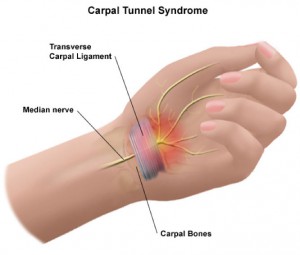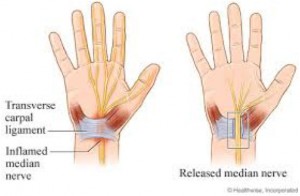Carpal Tunnel Release-Open
 Carpal tunnel syndrome occurs when the median nerve, which runs from the forearm into the palm of the hand, becomes pressed or squeezed at the wrist. The median nerve controls sensations to the palm side of the thumb and, as well as impulses to some small muscles in the hand that allow the fingers and thumb to move. The carpal tunnel – a narrow, rigid passageway of ligament and bones at the base of the hand – houses the median nerve and tendons. Sometimes, thickening from irritated tendons or other swelling narrows the tunnel and causes the median nerve to be compressed. In Open Carpal Tunnel Release surgery, the transverse carpal ligament is cut, releasing the median nerve. The size and shape of the incision may vary.
Carpal tunnel syndrome occurs when the median nerve, which runs from the forearm into the palm of the hand, becomes pressed or squeezed at the wrist. The median nerve controls sensations to the palm side of the thumb and, as well as impulses to some small muscles in the hand that allow the fingers and thumb to move. The carpal tunnel – a narrow, rigid passageway of ligament and bones at the base of the hand – houses the median nerve and tendons. Sometimes, thickening from irritated tendons or other swelling narrows the tunnel and causes the median nerve to be compressed. In Open Carpal Tunnel Release surgery, the transverse carpal ligament is cut, releasing the median nerve. The size and shape of the incision may vary.
Preparation for Carpal Tunnel Release- Open
Tell your health care provider what medicines you are taking. This includes medicines, supplements, or herbs you bought without a prescription.
- You may be asked to stop taking drugs that affect your blood’s ability to clot. These include aspirin, ibuprofen (Advil, Motrin), naproxen (Naprosyn, Aleve), and other drugs.
- Ask your health care provider which medicines you should still take on the day of your surgery.
- If you smoke, try to stop. Ask your health care provider for help. Smoking can slow healing.
- Let your health care provider know about any cold, flu, fever, herpes breakout, or other illness you may have before your surgery.
- You will usually be asked not to drink or eat anything for 6 – 12 hours before the procedure.
- Your health care provider will tell you when to arrive at the office. Arrive on time.
 Carpal Tunnel Release- Open Surgery
Carpal Tunnel Release- Open Surgery
During Open Carpal Tunnel Release surgery, the transverse carpal ligament is cut, which releases pressure on the median nerve and relieves the symptoms of carpal tunnel syndrome.
An incision is made at the base of the palm of the hand. This allows the doctor to see the transverse carpal ligament. After the ligament is cut, the skin is closed with stitches. The gap where the ligament was cut is left alone and eventually fills up with scar tissue.
If you have Open Carpal Tunnel Release surgery, you typically do not need to stay in the hospital. It is usually done under local anesthetic, and you can go home on the same day.
Carpal Tunnel Release- Open Recovery
After surgery, the hand is wrapped. The stitches are removed 10 to 14 days after surgery. The pain and numbness may go away right after surgery or may take several months to subside. Try to avoid heavy use of your hand for up to 3 months.
When you return to work depends on whether the dominant hand (the hand you use most) was involved, what your work activities are, and how much effort you put into rehabilitative physical therapy.
- If you have surgery on your non dominant hand and do not do repetitive, high-risk activities at work, you may return to work within 1 to 2 days, although 7 to 14 days is most common.
- If you have surgery on your dominant hand and do repetitive activities at work, you may require 6 to 12 weeks for a full recovery before you can return to previous work duties. Physical therapy may speed your recovery.
Risks for the Procedure
Risks of Carpal Tunnel Release-Open are:
- Allergic reactions to medicines
- Bleeding
- Infection
- Injury to the median nerve or nerves that branch off of it
- Weakness and numbness around the hand
- Rarely, injury to another nerve or blood vessel (artery or vein)
- Scar tenderness
